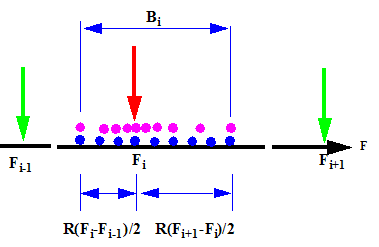| No. of
points for each frequency |
Sets the maximum number of
frequency points at which the response will be evaluated for each
mode. The limit on the total number of solution steps is 10000.
|
| Bandwidth around each frequency |
A ratio R that sets the range of
the solution frequency points around each natural frequency
considered in the analysis. For example, the full
range B i (R =1) for mode i extends
from (F i - F i-1)/2 to (F i+1 - F i)/2 as shown below: 
- A solution frequency point is used at
each natural frequency considered in the analysis. If
two consecutive modes are too close to each other, the
software uses a number of points smaller than No. of points for each
frequency.
- For the first mode, Fi-1 is considered 0. For the
last mode, the bandwidth is considered to be symmetrical
around the natural frequency.
- If the upper limit frequency, specified
in the Harmonic
Options tab, is much larger than the
highest natural frequency considered in the analysis,
the No. of points for each
frequency input is used to define
frequency points in that range.
|
| Interpolation |
|
Logarithmic
|
The solution frequency points are
clustered around each natural frequency logarithmically
to capture the response accurately at the natural
frequency neighborhood. The solution frequency points
are shown in pink in the figure above.
|
|
Linear
|
The solution frequency points are
distributed uniformly on the bandwidth. The solution
frequency points are shown in blue in the figure
above.
|
|
| Include
extra frequencies for response |
Select this option to include extra frequencies
of interest for the calculation of the response parameters to
harmonic loads.
In addition to the natural frequencies, which are included in the
harmonic analysis by default, you can select up to 20 extra
frequency points of interest. Enter the extra frequency points
in ascending order (positive values).
The number of solution frequency points at which
the solver calculates the response (that is, the clustered
frequency solution points between two consecutive frequencies)
is identical to the number of frequency points used for the
natural frequencies (see No. of
points for each frequency).
|
| Edit |
Select this option to enter up to 20 frequencies
in ascending order (positive values). |
| Tolerance to merge extra frequency points |
Sets a tolerance limit (%) that defines how close
an extra frequency point is to a natural frequency or to its
consecutive extra frequency point so that the solver can merge
the two consecutive frequencies into one frequency. The default
tolerance limit is 1%. The solver does not
apply the tolerance criterion to natural frequency points
(that is, natural frequencies are not merged).
|

 represents natural frequencies calculated by
the solver (all natural frequencies are included in the
calculation of RMS output). represents natural frequencies calculated by
the solver (all natural frequencies are included in the
calculation of RMS output).
 represents user-defined extra frequency points
to include in the calculation of RMS output. represents user-defined extra frequency points
to include in the calculation of RMS output.
 represents tolerance (%). represents tolerance (%).
For example, the solver merges an extra frequency
point to its closest natural frequency, based on the following
criteria:
|